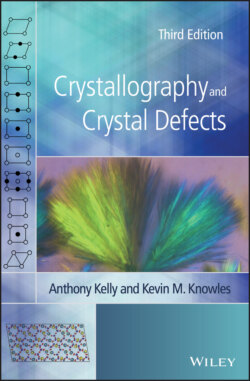Читать книгу Crystallography and Crystal Defects - Anthony Kelly - Страница 52
Problems
ОглавлениеMaterial in Appendices 1–3 may be useful; in Problem 2.12 the material in Appendix 4 may also be useful.
1 2.1 Using Figure 2.13, confirm that in the four‐index notation for a plane with indices (hkil):(Eq. (2.2).) Confirm also that the condition for a four‐index vector [UVTW] to lie in a four‐index plane (hkil) is:(Eq. (2.5).)
2 2.2 Show that the angle γ between any of the crystal axes and the unique triad axis in a trigonal crystal is given by:
3 2.3 The corners of a wooden model of a cube are cut off to make equal faces of the form {111}. The first four new faces are cut in positions (111), (11), (11) and (1), in that order. Draw sketch stereograms to show the symmetry elements shown by the model after each new face is formed. What is the crystal system of the model in each case?
4 2.4Sketch stereograms showing the operation of the undermentioned symmetry elements on two distinct poles, each in a general position, and insert the symmetry elements themselves, except the centre of symmetry:centre of symmetryvertical plane of symmetryhorizontal plane of symmetryvertical axes 2, 3, 4, 6vertical inversion axes , , , horizontal axes 2, 4horizontal inversion axis .The symbol is not used in conventional point group notation. Draw sketch stereograms of the poles of one general form for each possible value of X and hence derive the conventional symbols that are actually used.
5 2.5In which of the trigonal classes 3, , 3m, 32, and m does a rhombohedron occur as a special form? In what class is the rhombohedron the general form?Which of the tetragonal classes 4, , 4/m, 422, 4mm, 2m, and 4/mmm have closed forms as their general forms?To which of the cubic classes 23, m, 432, 3m and mm could a crystal belong which had the shape of (i) an octahedron, (ii) a tetrahedron or (iii) an icositetrahedron? (The icositetrahedron is the name given to the {112} form with 24 faces.)
6 2.6 In a holosymmetric cubic crystal the angle between (110) and a face P which lies in the zone [010] is 53.97°. Find the indices of P and calculate the angle between P and the face P′ related to P by the mirror plane parallel to (10). Determine the indices [uvw] of the zone containing P and P′ and calculate the interzone angle [uvw]∧[10].
7 2.7Calculate the angle between [0001] and [113] in beryllium (hexagonal, a = 2.28 Å, c = 3.57 Å). What face lies at the intersection of the zones [113] and [113]?In a crystal of calcite (trigonal; c/a = 0.8543), a face lies in the zone between (101) and (101) at an angle of 16.50° from (101). Determine the indices of this face.
8 2.8 In an orthorhombic crystal (topaz) with axial ratios a : b : c = 0.529 : 1 : 0.477, the following angles were measured to the face P of the general form: (100)∧P = 67.85°, (010)∧P = 66.5°. Determine the indices of P.
9 2.9 Calculate the axial ratios a : b : c and the axial angle β for a monoclinic crystal (gypsum) given that (110)∧(10) = 68.5°, (001)∧(10) = 82.3° and (001)∧(01) = 33.1°.
10 2.10In a hexagonal zeolite crystal the angle (100)∧(101) is found to be 37.2°. Calculate the axial ratio c/a and specify the indices of the zone containing both faces in (i) conventional three‐dimensional indices and (ii) the Weber 4‐index notation.Show that (0001)∧(112) = 48.8°. Hence, construct a stereogram centred on 0001 showing all the poles of the form {100}, {101}, {110} and {112} for this zeolite.
11 2.11 α‐sulfur forms orthorhombic holosymmetric crystals with a = 10.48 Å, b = 12.92 Å and c = 24.55 Å.Draw a sketch stereogram showing the symmetry elements shown by α‐sulphur.Calculate the angles (001)∧(011) and (100)∧(110). Insert these poles on a stereogram.Hence, draw an accurate stereogram of sulphur showing all the faces of the forms {100}, {010}, {001}, {101}, {110}, {111}, {011} and {113}. Index all the faces in the upper hemisphere. Which of these are general and which are special forms?
12 2.12 In dealing with some imperfect crystals with a cubic face‐centred lattice it is convenient to use a hexagonal unit cell. The cubic face‐centred lattice can be referred to a hexagonal cell where the z‐axis is parallel to [111] and of magnitude , where a is the lattice parameter of the conventional cubic unit cell and the x‐ and y‐axes are parallel to the 〈101〉 directions perpendicular to [111] and of magnitude .Draw a diagram showing the relation between the two unit cells.Write the hexagonal lattice vectors in terms of the cubic lattice vectors. Hence, derive the matrix for transforming the indices of lattice planes.Find the ratio of the volumes of the two unit cells by the matrix method and check by direct calculation. How many lattice points does each contain?Obtain the hexagonal indices of the planes with indices (112), (100) and (10) referred to the conventional cubic cell.
